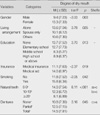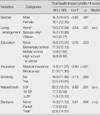Abstract
Purpose
This study was conducted to investigate the degree of dry mouth and oral health-related quality of life and to identify factors contributing to oral health-related quality of life for community-dwelling elders.
Methods
A descriptive correlational study design was used. Participants were 156 older adults from two senior welfare centers. Data were collected on February 21, 22 and 29, 30, 2009 using structured questionnaires. Enter type multiple regression analysis was used to identify factors influencing oral health-related quality of life according to general and oral health characteristics.
Results
There were significant differences in oral health-related quality of life according to living arrangement, insurance, smoking, number of natural teeth, and denture type. The oral health-related quality of life had significant correlations with the number of chronic disease, number of medications, and dry mouth. Factors influencing oral health-related quality of life for community-dwelling older adults were dry mouth, number of chronic disease, and medical aid, which explained about 47.9% of total variance.
Figures and Tables
Table 2
Differences in Degree of Dry Mouth according to General and Oral Health Characteristics (N=156)

Table 3
Differences in Oral Health-related Quality of Life according to General and Oral Health Characteristics (N=156)

Table 4
Correlations of Oral Health-related Quality of Life with General and Oral Health Characteristics (N=156)

References
1. Cassolato SF, Turnbull RS. Xerostomia: Clinical aspects and treatment. Gerodontology. 2003. 20:64–77.
2. Ciancio SG. Medications' impact on oral health. Journal of the American Dental Association. 2004. 135:1440–1448.
3. Coleman P. Improving oral health care for the frail elderly: A review of widespread problems and best practices. Geriatric Nursing. 2002. 23:189–199.
4. Coleman P. Opportunities for nursing-dental collaboration: Addressing oral health needs among the elderly. Nursing Outlook. 2005. 53:33–39.
5. Field EA, Fear S, Higham SM, Ireland RS, Rostron J, Willetts RM, et al. Age and medication are significant risk factors for xerostomia in an English population, attending general dental practice. Gerodontology. 2001. 18:21–24.
6. Fox PC. Management of dry mouth. Dental Clinics of North America. 1997. 41:863–875.
7. Gerdin EW, Einarson S, Jonsson M, Aronsson K, Johansson I. Impact of dry mouth conditions on oral health-related quality of life in older people. Gerodontology. 2005. 22:219–226.
8. Gonsalves WC, Wrightson AS, Henry RG. Common oral conditions in older persons. American Family Physician. 2008. 78:845–852.
9. Guggenheimer J, Moore PA. Xerostomia: Etiology, recognition and treatment. Journal of the American Dental Association. 2003. 134:61–69.
10. Ikebe K, Matsuda K, Morii K, Wada M, Hazeyama T, Nokubi T, et al. Impact of dry mouth and hyposalivation on oral health-related quality of life of elderly Japanese. Oral Surgery, Oral Medicine, Oral Pathology, Oral Radiology, and Endodontics. 2006. 103:216–222.
11. Jang JH, Baik SH, Kim AJ, Jung SH, Kim OS, Kim SH. The effect of xerostomia on perceived oral health among elderly people wearing dentures. Journal of Korean Academy of Oral Health. 2006. 30:438–446.
12. Jang MS, Kim HY, Shim YS, Rhyu IC, Han SB, Chung CP, et al. Association of self-reported periodontal health status and oral health related quality of life. Journal of Korean Academy of Periodontology. 2006. 36:591–599.
13. Jung Y, Shin D. Oral health, nutrition, and oral health related quality of life among Korean older adults. Journal of Gerontological Nursing. 2008. 34(10):28–35.
14. Kim B, Yun G, Seok S. Effects of individual reminiscence therapy on older adults' depression, morale and quality of life. Journal of Korean Academy of Nursing. 2006. 36:813–820.
15. 2008 Statistics on the aged. Korea National Statistical Office. 2008. Retrieved October 27, 2008. from
http://www.w3.org/1999/xlink" xlink:href="http://www.kostat.go.kr/eboard_faq/BoardAction.do?method=view&board_id=106&seq=217&num=217&parent_num=0&page=1&sdate=&edate=&search_mode=s_title&keyword=2008%20Statistics%20on%20the%20Ag&catgrp=eng2009&catid1=g01&catid2=g01b&catid3=&catid4=.
16. Lee J. Dry mouth in the Korean elderly: Association factors, and impact on oral health related quality of life. 2006. Seoul: Seoul National University;Unpublished master' thesis.
17. Lee M, Kim S, Yang J, Oh J, Kim D. Validity and reliability of the oral health impact profile in elderly Korean 65+. Journal of Korean Academy of Oral Health. 2005. 29:210–221.
18. Locker D. Dental status, xerostomia and the oral health related quality of life of an elderly institutionalized population. Special Care in Dentistry. 2003. 23:86–93.
19. Matear DW, Locker D, Stephens M, Lawrence HP. Associations between xerostomia and health status indicators in the elderly. The Journal of the Royal Society for the Promotion of Health. 2006. 126:79–85.
20. Park J. The effects of an elderly health promotion on health promotion lifestyle, health status, quality of life in the elderly. Journal of Korean Academy of Nursing. 2004. 34:1194–1204.
21. Petersen PE, Yamamoto T. Improving the oral health of older people: The approach of the WHO global oral health programme. Community Dentistry and Oral Epidemiology. 2005. 33:81–92.
22. Slade GD, Spencer AJ. Social impact of oral conditions among older adults. Australian Dental Journal. 1994. 39:358–364.
23. So JS. Prevalence and severity of dry mouth in the Korean elderly. 2005. Seoul: Seoul National University;Unpublished doctoral dissertation.
24. 2004 A national survey on the living status and welfare needs of the aged. The Korea Institute for Health and Social Affairs. 2004. Retrieved February 18, 2009. from
http://www.mw.go.kr/front/jb/sjb030301vw.jsp?PAR_MENU_ID=03&MENU_ID=03030301&BOARD_ID=1003&BOARD_FLAG=03&CONT_SEQ=32392&page=1.
25. Thomson WM, Chalmers JM, Spencer AJ, Williams SM. The xerostomia inventory: A multi-item approach to measuring dry mouth. Community Dental Health. 1999. 16:12–17.
26. Turner MD, Ship JA. Dry mouth and its effects on the oral health of elderly people. Journal of the American Dental Association. 2007. 138:15S–20S.
27. Oral health in America: A report of the surgeon general. U.S. Department of Health and Human Services. 2000. 05. 25. Retrieved March 15, 2010. from
http://silk.nih.gov/public/hck1ocv.@www.surgeon.fullrpt.pdf.




 PDF
PDF ePub
ePub Citation
Citation Print
Print




 XML Download
XML Download